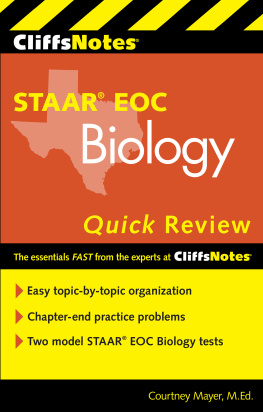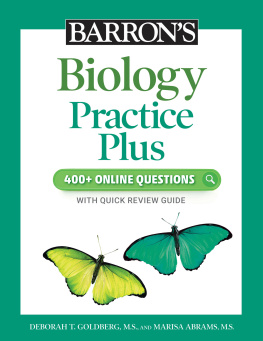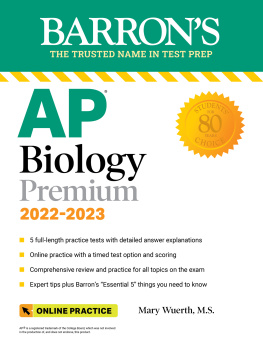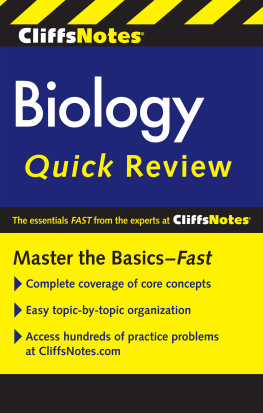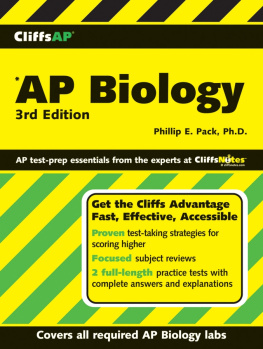Table of Contents
INTRODUCTION
C liffsNotes STAAR EOC Biology Quick Review is a reference tool that will help you review the important elements of biology necessary to master the STAAR End of Course (EOC) Exam.
What Is STAAR End of Course?
STAAR stands for State of Texas Assessments of Academic Readiness, and EOC stands for end of course. Texas high school students must meet a Satisfactory Academic Performance (Level II) on each EOC assessment they take in order to graduate.
Students will be tested in five areas:
Cell Structure and Function ()
Mechanisms of Genetics ()
Biological Evolution and Classification ()
Biological Processes and Systems ()
Interdependence within Environmental Systems ()
Important facts about the STAAR EOC Biology Exam
The exam consists of 54 multiple-choice questions.
Students will have 4 hours to complete the STAAR EOC Biology Exam. Students are allowed to take breaks to get a drink of water, have a snack, or use the restroom, but the test clock will not pause for these breaks. Practice timing yourself while taking the two full-length practice tests in to best prepare yourself for the timed setting of the actual exam.
Students will have access to a handheld, four-function, scientific or graphing calculator. There will be at least one calculator for every five students on the day of the test. If a calculator is used by multiple students, its memory must be cleared after each use.
The test may be administered as a paper-and-pencil exam or on a computer. The test administration method varies by school and by school district.
No formula chart is allowed during the administration of the test; any necessary information will be embedded in the test questions.
For additional information on the STAAR EOC Biology Exam, visit http://tea.texas.gov/student.assessment/staar/science.
How to Use This Book
There are a number of ways you can use this book to prepare for the STAAR EOC Biology Exam. You decide what works best for your needs. Here are a few suggested approaches:
Approach 1:
Take Practice Test 1 () as a diagnostic test to see what areas you need to focus on most. Check your answers and identify the topics of the questions you missed.
Review these topics in .
Answer the Chapter Check-Out questions at the end of each chapter to make sure you understand the content.
Take Practice Test 2 () for final practice.
Approach 2:
Read chapters .
Answer the Chapter Check-Out questions at the end of each chapter to make sure you understand the content.
Take Practice Test 1 () for practice.
Take Practice Test 2 () for additional practice.
Approach 3:
Answer the Chapter Check-Out questions at the end of each chapter. Review the related chapter content for any questions you missed.
Take Practice Test 1 () for practice.
Take Practice Test 2 () for additional practice.
Chapter 1
CELL STRUCTURE AND FUNCTION
Chapter Check-In
C ells were unknown to us for many centuries. You and every other living thing are made of cells. Cells are the smallest unit of life and have different structures and functions depending on where in the body they are found or what organism they are found in. In this chapter, we will look at the history of the cell and cell theory. We will also study cellular structure, function, and transport. We will learn how cells divide to make new cells and which biomolecules are needed for each cell part to function. We will also look at viruses, which, though not technically alive, can affect cells and our bodies.
Prokaryotic and Eukaryotic Cells
History of the cell and cell theory
In 1665, Robert Hooke looked under a compound microscope at a piece of cork, a type of plant material found in the bark of an oak tree. He noticed that there seemed to be tiny compartments that looked to him like the rooms that are found in a monastery that monks lived in. In a monastery, these small rooms were called cells and, thus, the name of the cell was born. About the same time, a Dutch biologist named Anton van Leeuwenhoek had developed a more powerful microscope and was looking at organisms he found swimming in pond water. We now know these to be protozoans, although, at the time, he called them animalcules.
In 1838, German scientist Matthias Schleiden was studying plant cells under a microscope and noted that all plants were made of cells. About the same time, another German scientist, Theodor Schwann, concluded that all animals are made of cells. In 1855, a third German scientist, Rudolf Virchow, discovered that all cells come from preexisting cells.
These discoveries led to the cell theory, which states:
All living things are composed of cells.
Cells are the basic units of structure and function in living things.
New cells are produced from existing cells.
Cells can be put into two categories: those with a nucleus and membrane-bound organelles and those without. The nucleus contains the genetic material for the cell, and the organelles are the structures within the cell that perform specific functions. (We will get into the organelles and nucleus in the section later in this chapter.)
Prokaryotic cells
Prokaryotic cells are simple cells that lack membrane-bound organelles. The genetic material for prokaryotic cells is just floating around in the cytoplasm and not bound in a nucleus. All bacteria are prokaryotic. Below is a picture of a prokaryotic cell (). Can you see how the DNA is located in a nucleoid region and not in its own organelle? Also, do you notice the lack of membrane-bound organelles? The simple nature of the prokaryotic cell suggests to scientists that the first cells to evolve were prokaryotic.
Figure 1-1 Prokaryotic cell.

Eukaryotic cells
is an example of a typical animal cell.
Figure 1-2 Animal cell.
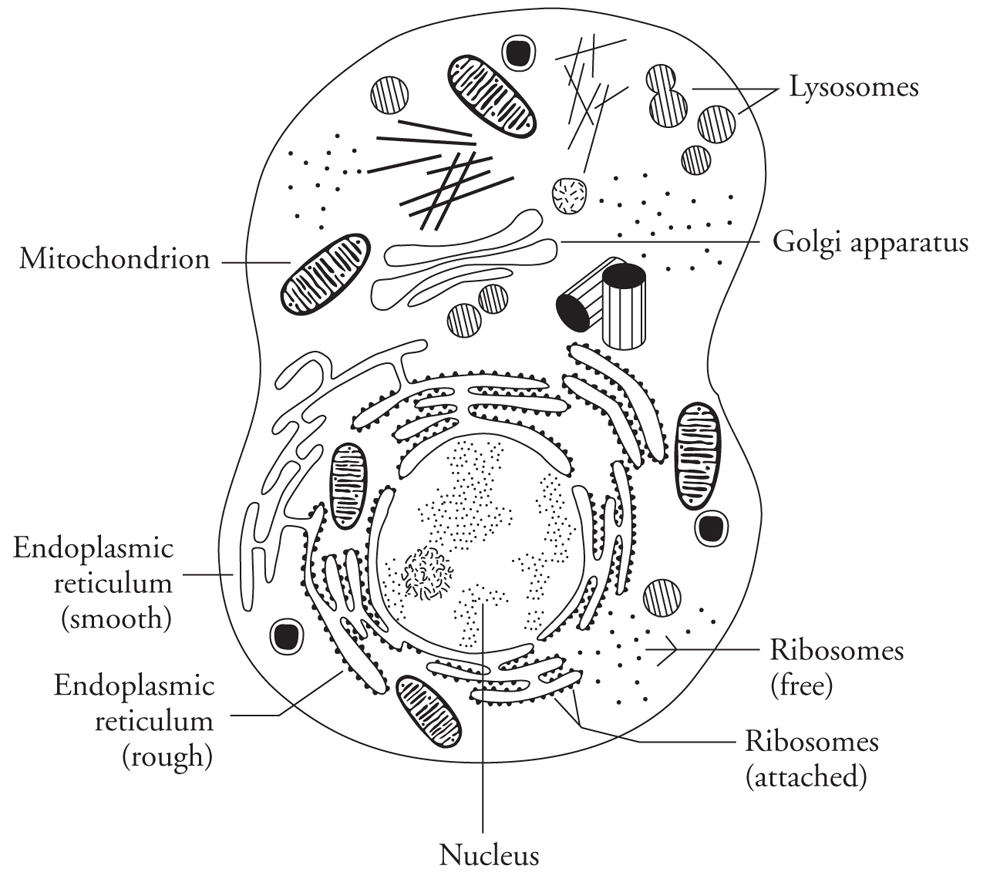
We will go through each organelle and the function/role it plays in the cell. To do this, lets compare the cell to a city.
Structure and function
Nucleus The nucleus controls all the functions of the cell. In our city example, the nucleus would be the town hall. The town hall is where decisions are made in a city, and, similarly, the nucleus is where decisions are made in the cell. If the cell were your body, the nucleus would be the brain. The nucleus also contains most of the cells DNA, which is used to make proteins for cell growth and reproduction.
The nucleus has a cell membrane surrounding it that is called the nuclear membrane. The nuclear membrane is double-layered and has many holes called pores that allow materials to go into and out of the nucleus. The nuclear membrane also functions to keep things out of the nucleus that could harm the genetic material inside. The nucleus contains the nucleolus, where ribosomes are made. (We will discuss ribosomes in more detail in .)

